Physical Address
304 North Cardinal St.
Dorchester Center, MA 02124
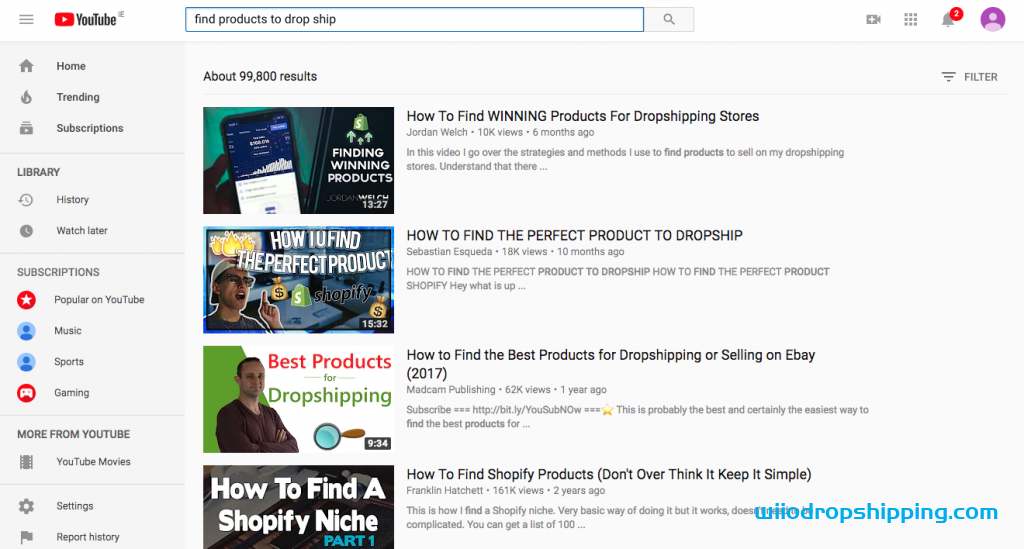
The year 2022 is here and plenty of online resellers are asking themselves: Is dropshipping still worth it? This question pops up all the time, but fortunately, there’s a short and sweet answer: Yes, definitely!
It seems like every year there’s a wave of articles and blog posts claiming that dropshipping is dead. However, the underlying strengths and incredible benefits of the dropshipping model make it unlikely that it will ever truly fail.
If you make sure that your store is profitable and you give consumers what they want, then you can keep going strong in 2022 and beyond – there’s plenty of money to be made!
Dropshipping, in a nutshell, is a business model whereby an online store doesn’t own the inventory it sells. Instead, when a customer places an order, the store purchases that item from a third party that will then ship it directly to the buyer.
Put another way, the online store is a middleman, taking orders from customers, which it then forwards to a supplier or manufacturer to fulfill on its behalf.
The practice is often touted as a get-rich-quick scheme for sellers. The internet is littered with videos, blogs and online tutorials from people who claim to have made thousands of dollars—often overnight—by setting up a dropshipping store.
On the face of it, dropshipping sounds like a no-brainer: no upfront investment and no inventory to store. In most cases, the seller never even comes into contact with the products he or she sells. But in reality, it’s more complicated than that.
Dropshipping might be the buzzword du jour of e-commerce, but big companies have used it for years to help scale their businesses.
Take Zappos, for example. When the online shoe giant first launched, it fulfilled orders with drop shipments. But as CEO Tony Hsieh explained in Harvard Business Review, the system was flawed from the get-go.
“We didn’t have 100 percent accurate information about our vendors’ inventory and because their warehouses were all over the country, delivery times weren’t predictable,” he said. “As an e-commerce company, we should have considered warehousing to be our core competency from the beginning. Trusting that a third party would care about our customers as much as we did was one of our biggest mistakes.”
Similarly, before Amazon began building its own warehouses, it also relied on wholesalers and distributors to ship CDs and books directly to its customers.
Home goods e-tailer Wayfair doesn’t stock most of the merchandise it sells either. Instead, manufacturers ship orders to buyers because, as Wayfair board member Alex Finkelstein told Boston Globe, “you can’t stock 500 different couches in 75 different colors in a warehouse.”
While retailers large and small utilize dropshipping in order to offer a broader selection of goods on their online stores, without the need to invest in inventory and warehouses, e-commerce entrepreneurs have adopted it as a means to capitalize on consumer trends and make a quick buck.

A search for “find products to drop ship” on YouTube returns nearly 100,000 results, all dispensing the same advice:
Sounds like Retail 101, right? But the big difference between setting up a traditional e-commerce business and a dropshipping store is startup expenses: a basic Shopify subscription costs $29 a month, suppliers aren’t paid until an item is sold and Facebook advertising costs about $0.27 per click on average.
There’s even an application that will do most of the work. Oberlo allows sellers to import drop-shipped products directly into their Shopify or Amazon store from AliExpress.
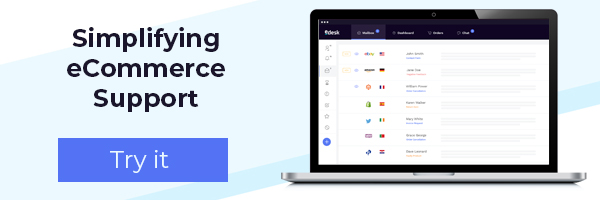
Have you ever been scrolling through your Instagram or Facebook newsfeed and noticed an ad for an accessory or clothing brand you’ve never heard of that’s hawking a limited-time “free plus shipping” deal on a product?
Chances are, it’s a dropshipping store—and consumers are cottoning on.
The Atlantic’s Alex Madrigal started digging into it after he fell for an Instagram ad for an inexpensive camel coat from an unfamiliar brand called West Louis that wound up being made from a cheap fabric “so synthetic, it could probably be refined into bunker fuel for a ship.”
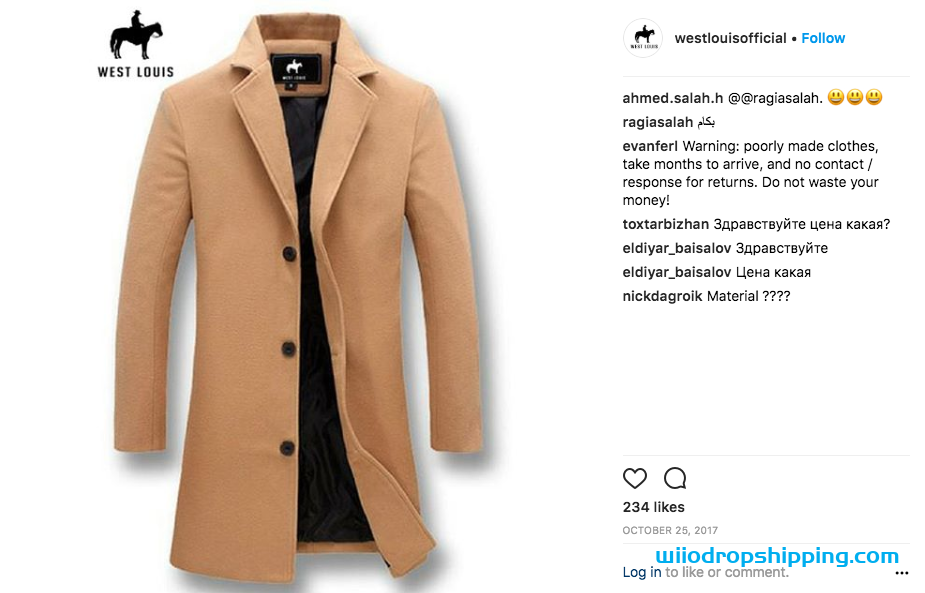
After doing a reverse image search of the coat, he found it was being sold on several websites around the world—all of which used the same product images. Similarly, a sweatshirt he bought from a store called Thecuttedge.life via Instagram was also available on at least 15 other sites.
Likewise, artist Jenny Odell looked into the origins of a flimsy watch from a company called Folsom & Co. after someone gifted it to an exhibition she was working on at the Museum of Capitalism in Oakland, California, explaining that a seemingly San Francisco-based company used Instagram to sell it for free but with $7 shipping.
A few reverse image searches later, Odell discovered the same watch was being sold under different product names by SoFi Coastal and Regent & Co., to name just two, and that all stores seemed to have sourced their stock from AliExpress.
Folsom & Co. still sells watches, but it’s expanded its range to include swimwear, leggings, bags and accessories.
One pair of Folsom & Co. leggings, dubbed “Khloe” and retailing for $31, is also being sold for $49.99 by a company called Yogi Fire, for £6.63 on Amazon and for $10.13 on AliExpress.
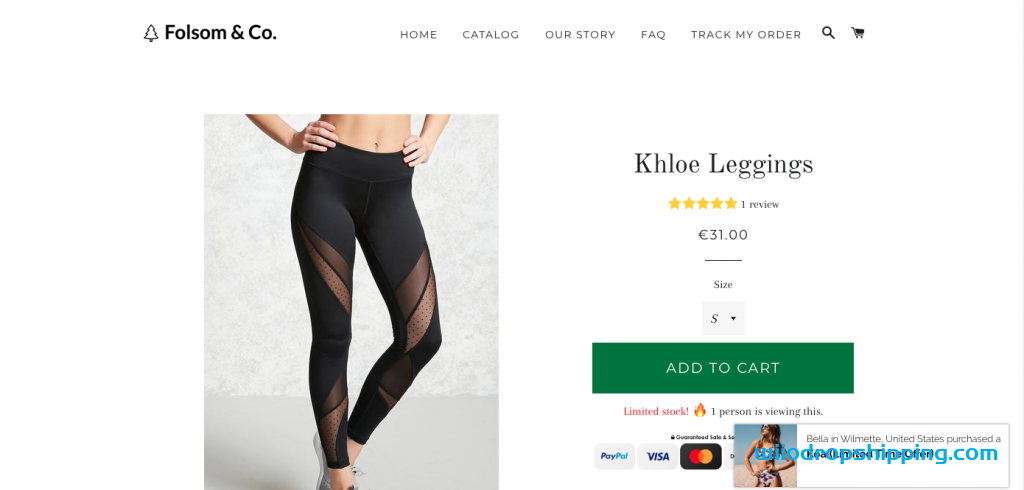
All four listings feature the exact same product images. Hilariously, the AliExpress product description notes “quality is not very good, so the price is cheap enough,” while Folsom & Co. says “this essential is made with premium materials that are made to last.”
Of course, the average consumer doesn’t do a reverse image search of a product they’re thinking of buying online. And most dropshipping stores all use the same basic strategy to sell their goods: run a limited-time flash sale to make the customer think they’re getting a good deal, then up the ante with a ticking clock that shows when the deal expires as well as live pop-ups of how many people are currently viewing it.
But just because consumers are falling for it doesn’t mean they don’t flip out when their “free” premium product shows up looking and feeling a lot less luxurious than advertised.
One irate post on Folsom’s Instagram profile reads: “Scam. Been waiting 2 months for my bikini and still never came. On top of the fact that they won’t respond to my complaints. Don’t waste your money y’all.”
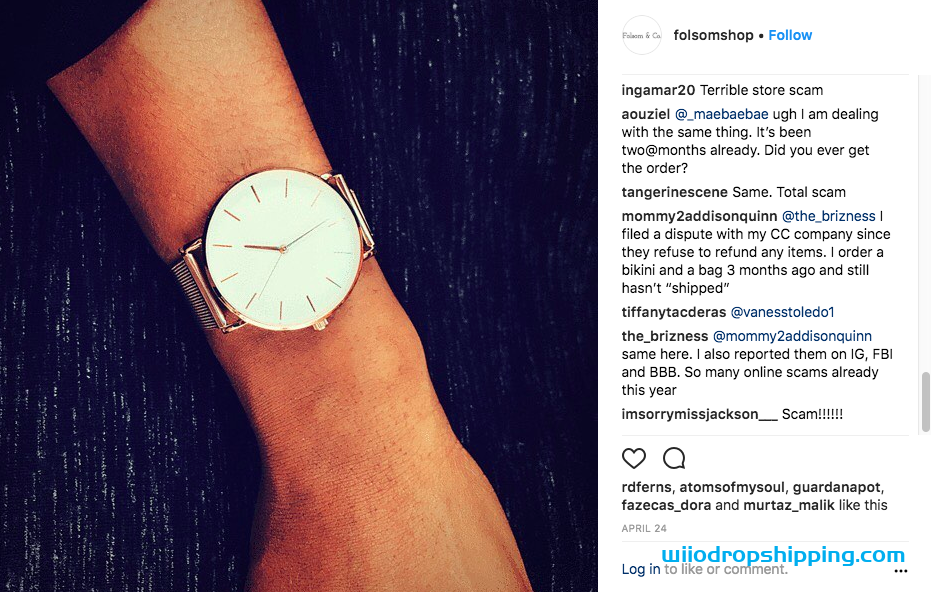
The concept is simple: you list products for sale on your site. The products themselves are manufactured and held by a third party. When someone places an order, the third party ships them directly to the consumer.
The ability to add inventory without having to deal with production, stocking, or fulfilling orders may seem like a dream. And the success of well-known brands that were built on dropshipping, like Wayfair, make it all the more tempting.
But is dropshipping worth it? Let’s explore some of the advantages and disadvantages to help you make the best decision for your business.
Both traditional and online stores often require a hefty financial investment to develop, manufacture, and source products. Additional costs associated with stocking inventory, maintaining a physical presence, staffing locations, and marketing to new customers can really add up!
Dropshipping has a much lower barrier to entry because you don’t have to worry about developing new products or purchasing and storing inventory.
Traditionally, retailers pay upfront production costs, wait for delivery, and then stock products in a shop or warehouse. If a product isn’t available for customers when they want to make a purchase, sales are lost.
Inventory management also requires storage and handling costs — someone has to fold shirts and put them on the shelves! And you might purchase or manufacture large volumes of inventory that don’t sell, so there’s significant financial risk involved.
Businesses that dropship, on the other hand, remove those risks. A third party handles inventory, and products are available to the customer on demand.
Dropshipping nixes the need for a physical storefront — which means no lease, no mortgage, no construction costs, no upkeep.
Typically, retailers purchase products, wait for them to arrive, and then sell them to customers. For a period of time, they’ve spent a significant amount of money without the ability to make it back.
With dropshipping, you receive payment for the products at the same time you pay your providers — or before. This frees up cash for marketing and growth.
Innovation is critical for keeping customers engaged, but fear of investing money into new products with unproven track records prevents many business owners from moving forward.
Dropshipping lets you test new product lines without spending lots of money. If customers don’t respond to a new item, simply remove it from your store!
Passive income is earned with little to no daily effort (though it does require upfront work and consistent monitoring). With dropshipping, it’s very possible for you to be working on other aspects of your business (or even be asleep!) while orders are placed and fulfilled automatically. With a traditional retail model, products couldn’t go out without your involvement.

The same low barrier to entry that makes dropshipping attractive creates heavy competition. Other stores aren’t selling similar products — they’re selling the same products from the same third-party manufacturers. You’ll have to find other ways to stand out in order to compete.
When dropshipping, inventory rarely passes through your hands, so you don’t have the chance to ensure that products are in top condition. Without quality control, you’re putting your store’s reputation in the hands of a third party. One bad batch of products could lead to unhappy customers and lost sales. And unless you have a special deal with your suppliers, you can’t use packaging to make your store unique, include coupons to drive additional purchases, add thank you notes that encourage customer loyalty, or customize boxes and envelopes.
Fee structures can also be complicated and can change with little notice. As your store grows and develops a strong reputation, you can start negotiating exclusive deals with suppliers. But until then, you’ll have less favorable profit margins and be a lower priority for vendors. High fees can quickly eat away at profits or force you to price goods out of reach for your customers.
One of the reasons big box retailers can sell products at such low prices is economies of scale. They get major discounts on products because they purchase such a large volume, and they pass those discounts on to shoppers.
With dropshipping, you can say goodbye to bulk discounts, since you’re essentially purchasing products one at a time. Until you generate enough sales to give you some negotiation leverage, you’re paying what the suppliers ask.
If you have a variety of products listed on your store, they may come from different suppliers. Customers may receive multiple packages for the same order, which can lead to high shipping costs, wasteful packaging, confusing branding, and annoyed customers.
Differentiating your store can be difficult. Many stores try to compete on price but, with so much competition, find themselves setting lower and lower prices. If you’re not careful, you’ll sell lots of inventory, but at prices so low that you end up losing money.
While you could argue that a consumer shouldn’t expect a premium-quality product for only the price of shipping, especially when it’s something purchased through an Instagram ad, sellers still have to handle any problems, complaints and queries that arise during the transaction.
Remember, as Zappos CEO Tony Hsieh discovered back in the day, dropshipping delivery times aren’t predictable, particularly if the item is coming from China. And as far as your customers are concerned, if they’re left waiting three months to receive an order, the fault is yours—and you have to deal with the chargebacks.
Not to mention, if you sell a product that you didn’t first request a sample of, you’re taking it for granted that it’s as described. If it’s not and your customer is unhappy, you have to handle the fallout. The same goes for when your supplier runs out of stock after a customer has already placed an order with you.
But customer service issues aren’t the only problems you could run into. As the podcast Reply All pointed out, “the big money in dropshipping seems to be in teaching people that there’s big money in dropshipping.”
For example, online training program Drop Ship Lifestyle offers courses priced from $1,297 to $4,997 (the latter includes a ticket to a dropshipping retreat in Bali) that promise to teach people how to “gain freedom through entrepreneurship by starting a business that provides real value to your customers and to your bank account.”
The program was founded in 2012 by Anton Kraly, who set up his first e-commerce store in 2007 for a $29 investment and made over $1 million in sales in his second year in business.
But Kraly is the exception, not the rule. One drop-shipper interviewed on Reply All revealed she had only had two sales in a year.
Another said he lost so much money through dropshipping that he wound up sleeping on someone’s couch because he couldn’t afford to pay his rent. And yet today he’s peddling his own online dropshipping course, which pulled in $28,000 in its first month of existence.
It’s been said that 20 percent of new businesses fail in their first year—and it’s not hard to imagine that statistic is much higher for dropshipping stores, especially given how saturated the market has become.
That said, it doesn’t mean e-commerce success is impossible. Smart product research and sourcing and picking a sales platform that will help you reach your target audience will be key to whether your dropshipping business will boom or go bust.
As with any online store, focus on providing exceptional customer service where possible and encourage shoppers to leave you a review if they’re happy with their purchase. As consumers become increasingly skeptical of strange brands on Instagram, a great reputation will go a long way toward building your business.